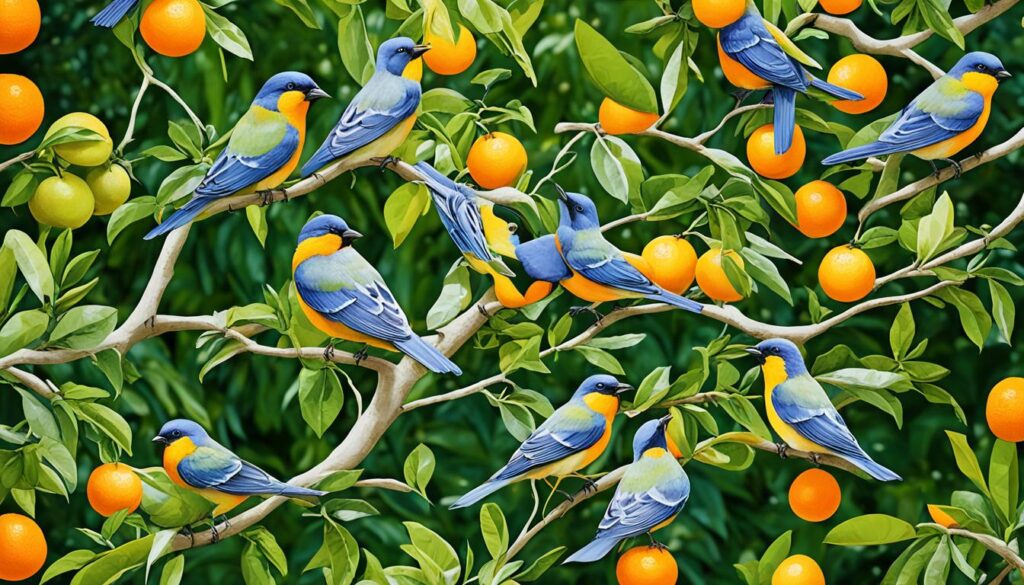Did you know 11 bird species across the United States love eating oranges? These include well-loved orange-loving avians such as orioles. Also, they consist of tanagers, lazuli buntings, house finches, and grosbeaks. These birds make watching them in your yard a special treat as they enjoy their orange feasts.
When spring arrives, birds that love oranges return from the south. They join other orange-consuming feathered friends in eating these nutrient-rich fruits. If you’re into birds or nature, you’ll appreciate knowing about these orange-craving avians. It’s a great way to attract them to your yard and create a beautiful spot for them.
Key Takeaways
- Backyard birds like orioles, tanagers, buntings, finches, and grosbeaks are known to relish oranges.
- These tropical fruit foragers are often migratory species that return in spring to feast on the citrus bounty.
- Offering oranges in your garden can attract a diverse array of colorful, fruit-eating birds to your backyard.
- Maintaining a clean, fresh orange feeder is key to keeping these birds that enjoy oranges coming back.
- Diversifying your bird feeding options with oranges can introduce new and fascinating species to your avian visitors.
Introduction to Fruit-Loving Avians
Spring brings back migratory birds and turns backyard feeding areas into something new. Homeowners change suet feeders to orange halves. This change welcomes fruit-loving birds to enjoy the “orange buffet” in backyards.
Many sweet-toothed birds, besides orioles, find their way to these feeding stations. The colorful Lazuli Buntings and the common House Finches are among the guests. Oranges attract an exciting mix of birds, making backyard bird watching more interesting.
“Discovering which unexpected birds will join the orange feast is part of the joy of backyard birding. It’s a delightful way to attract new, vibrant species and observe their unique behaviors.”
For bird watchers new and old, adding orange feeders brings a great bird show. From Orioles to Tanagers, these birds offer amazing sights for anyone interested.
With the birds returning, try putting out oranges in your yard. This simple act might bring rare and colorful visitors. It can be a fun and educational experience about fruit-loving birds.
Orioles: The Iconic Orange Enthusiasts
Types of Orioles and Their Citrus Cravings
Orioles are famous for their love of oranges and other citrus fruits. These colorful birds fly around our yards looking for these sweet snacks. North America is home to many oriole species, but a few really love oranges more than the others.
The Baltimore oriole is often seen in the East, with its black and orange colors. It can’t wait to get its beak on oranges, often finishing a feeder’s supply quickly. Out in the West, the Bullock’s oriole enjoys the same backyard orange feast.
Then, there are friends like the Orchard oriole and the Hooded oriole who also adore oranges. The Orchard oriole is seen in the East and Midwest, while the Hooded oriole lives in the Southwest, near fresh oranges.
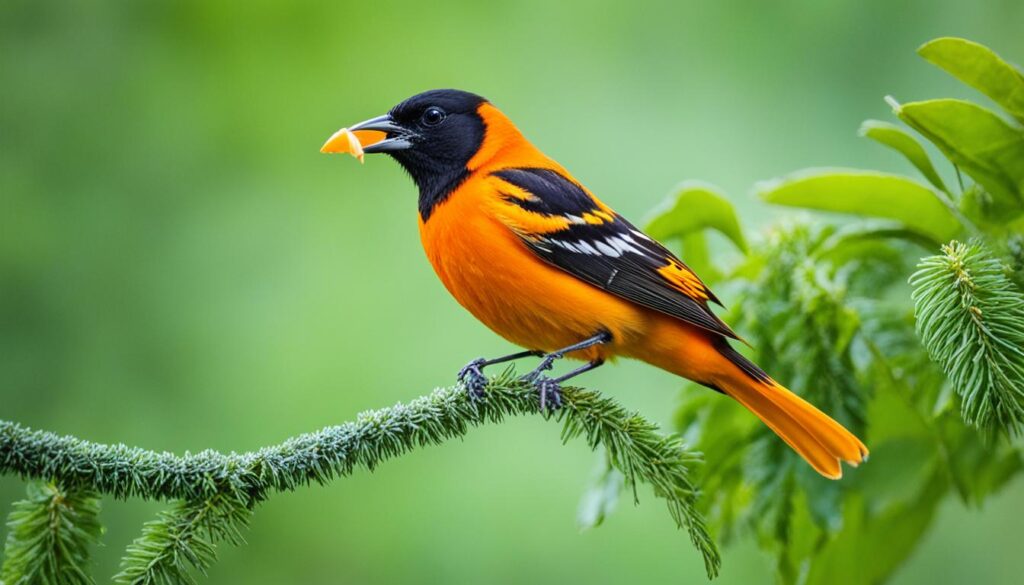
Amazingly, there are eight kinds of orioles in North America, with five being common. During summer, you can see at least one of them almost anywhere in the U.S. as they migrate around the country.
Orioles eat sweet food like nectar, apples, pears, and oranges. If you put out these treats, you’ll enjoy watching them play and eat in your yard.
Tanagers: Tropical Visitors with a Sweet Tooth
As the days lengthen and it gets warmer, colorful migratory birds show up in yards across North America. These include the eye-catching tanagers, known for their love of fruit and bright colors. They make birdwatchers happy with their vivid hues and fondness for fruity snacks.
The Western tanager, for instance, loves oranges. It surprises many people to see tanagers eating oranges, as they’re usually thought to eat seeds. But during spring migration, these birds coming from Central and South America switch to enjoying fresh citrus fruits.
Both tanagers and orioles enjoy oranges for their nectar and sugary pulp. On their way north, these birds look for orange fruits to eat. By offering oranges in your yard, you can watch these tropical visitors enjoy a sweet snack.
The orange-loving family isn’t just the Western tanager. Others, like scarlet and summer tanagers, also join in if there are oranges around. They bring their red, yellow, and black colors to the mix.
| Tanager Species | Plumage Colors | Migration Range |
|---|---|---|
| Western Tanager | Yellow, black, and red | Western North America to Central America |
| Scarlet Tanager | Bright red and black | Eastern North America to South America |
| Summer Tanager | Solid red | Southeastern United States to Central America |
| Hepatic Tanager | Reddish-orange and black | Southwestern United States to Central America |
By offering oranges to tanagers, you not only enjoy their beauty but also support their long trips. These little fruit fans give us a chance to see the charm and variety of birds in nature.
Lazuli Buntings: Unexpected Orange Admirers
Many bird lovers know about orioles and tanagers at backyard citrus feeders. But, the lazuli bunting is a surprise. These birds usually eat white proso millet. However, they’ve been seen enjoying oranges too.
Lazuli buntings catch the eye with their bright blue feathers and orange chests. Recent studies show these birds also visit orange feeders. This news delights bird watchers. It shows the variety of birds that enjoy fruit.
“I was absolutely thrilled to see a pair of lazuli buntings flitting around my orange feeder, happily nibbling on the juicy segments,” said avid birdwatcher Emily Wilkins. “It just goes to show that even birds we typically associate with seed-based diets can develop a taste for citrus treats.”
Buntings, like the lazuli bunting, prefer softbill diets. This includes fruit, nectar, and homemade soft food more than seeds. Their varied diet makes them great visitors in backyards.

Knowing about birds like the lazuli bunting helps backyard fans. They can make more welcoming feeding areas for different birds. Whether it’s orioles, tanagers, or “surprising fruit-lovers,” there’s food for every bird at the backyard citrus buffet.
House Finches: The Faithful Orange Fans
If you’re looking to attract vibrant, year-round visitors to your backyard, consider the house finch. These birds love oranges and stay loyal to them, even after other birds go away in the spring.
Orange-loving seed-eaters, they are called. What makes them such fans? It’s all about adaptation. House finches enjoy the sweetness of oranges. The young ones learn this from their parents. The more oranges they eat, the redder the male’s feathers can be.
Attracting and Feeding House Finches with Oranges
Feeding house finches with oranges is easy and fun. You can put fruit halves on hooks or in feeders. The birds will come quickly to enjoy the easy orange feeding spots.
House finches bring joy all year round. By offering them oranges, you’ll see their bright colors and care for their well-being. They will make your backyard a better place for all birds.
“One of the biggest irruption years in recorded history for the finches,” as per Andrew Del-Colle of Audubon Magazine.
So, if you want your backyard full of lively, orange-loving birds, go for house finches. These seed-eaters will surely make your place more vibrant. They will turn into your favorite feathered friends.
Grosbeaks: Chunky-Beaked Citrus Connoisseurs
Backyard orange feeders attract many bird species, including grosbeaks. These birds are known for their big beaks, especially the striking black-headed and rose-breasted grosbeaks. They love the taste of sweet oranges. Even though their main food is bird seed, they sometimes pick oranges, just like orioles do.
Part of the Cardinalidae family, grosbeaks stand out with their love for oranges. This family includes buntings, cardinals, and others. Grosbeaks use their strong, pointy beaks to open seeds. Still, they show they enjoy variety by eating oranges too.
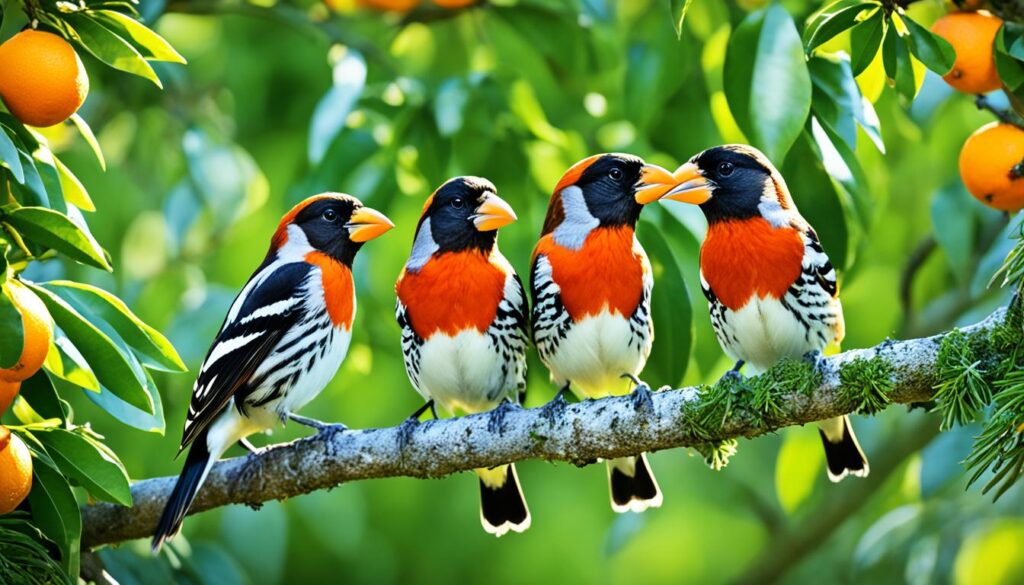
The black-headed grosbeaks impress with their black and gold feathers. Meanwhile, the rose-breasted grosbeaks show off their beautiful rose colors. These lovely birds add beauty to areas where people feed them oranges. Their presence makes watching them a special moment.
“Grosbeaks are a true testament to the joy that can be found in appreciating the simple pleasures of nature, like the sweet taste of a ripe orange.”
Giving out fresh oranges helps attract grosbeaks to your yard. This creates a fun bird-watching scene. You get to see these birds enjoying their time around oranges. It’s a great way to enjoy nature right at home.
Other Feathered Friends at the Orange Buffet
Orioles, tanagers, and buntings love oranges. But, many other birds do too. You can see woodpeckers, thrashers, catbirds, and mockingbirds on the orange buffet.
Woodpeckers, Thrashers, and More
Red-bellied and downy woodpeckers enjoy the sweet orange fruit. Thrashers and catbirds also like it. Though the author hasn’t seen these at her feeder, they are common in both eastern and western U.S. orange feeders.
Oranges attract these birds because they are high in sugar. They also find them easy to eat. You’ll get a lot of different birds if you offer oranges in your yard. It will be like running your own “citrus café.”
| Bird Species | Attraction to Oranges |
|---|---|
| Woodpeckers (Red-bellied, Downy) | Drawn to the sweet, juicy flesh of oranges |
| Thrashers | Members of the mimid family that enjoy orange treats |
| Catbirds | Also part of the mimid family and fond of oranges |
| Mockingbirds | Diverse orange-eaters that may visit orange feeders |
“A diverse array of Eastern and Western U.S. birds, from woodpeckers to mockingbirds, will readily partake in the orange-themed buffet.”
Setting Up Your Backyard Orange Feeding Station
Attracting birds with oranges is fun and adds color to your yard. It’s great for both those who love birdwatching and those new to it. Setting up an DIY orange feeders area isn’t as hard as it seems.
One easy way is using shepherd’s hooks or platform feeders. Place halves of oranges on them strategically. This way, birds find the visible orange offering easily. You can also make your own DIY orange feeders by fixing oranges with nails or screws.
To attract birds, put the feeders where they’re visible. Trees and shrubs nearby can serve as perches. Think about the season too. Oranges last longer in spring’s cooler weather. In summer, you’ll need to replace them more often.
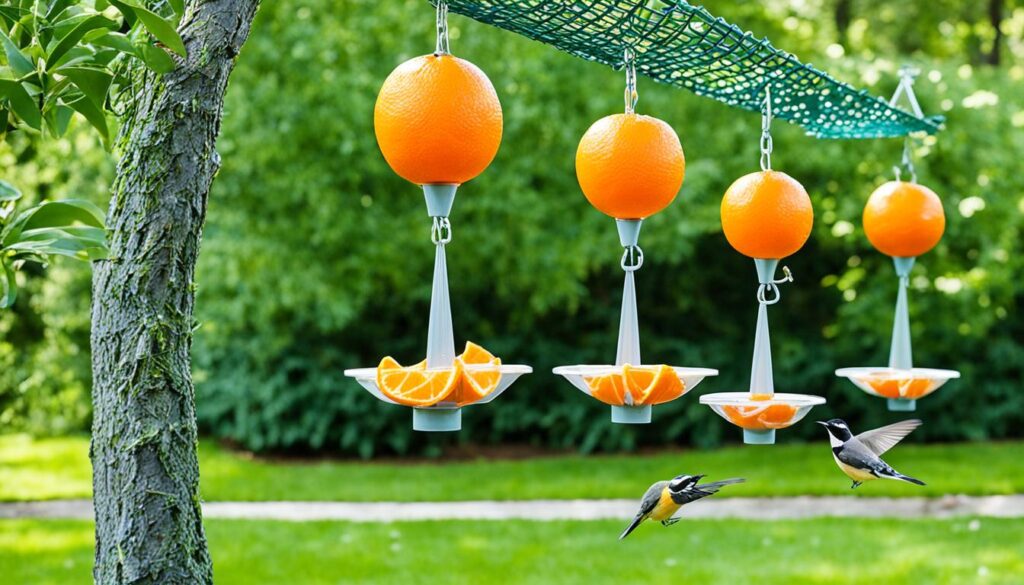
Setting up your orange feeding station can be very rewarding. You’ll see orioles, tanagers, and others enjoying the fruits. With a bit of effort, you can create a place where colorful birds come regularly.
Best Practices for Maintaining Orange Feeders
Keeping Feeders Fresh and Clean
It’s vital to provide fresh, juicy oranges to draw and keep orange feeder friends content. Yet, taking care of these orange feeders is a commitment. The fresh fruit attracts spoilage fast, especially when it’s warm.
Experts recommend frequent orange feeder maintenance, with a thorough clean and refill every few days. In the summer heat, you might have to change the oranges daily. This step helps avoid food spoilage, making the cleaning feeders inviting for the birds.
- Check feeders daily and remove any spoiled or dried-out orange slices.
- Wash feeders thoroughly with warm, soapy water and rinse completely to remove any sticky residue.
- Dry feeders completely before refilling with fresh orange slices.
- Consider using a feeder designed specifically for citrus fruits to minimize mess and spoilage.
By making sure your orange feeder is stocked with fresh, clean fruit, you keep your bird guests happy. This way, the birds will keep coming back for more throughout the year.
Attracting Other Birds with what birds eat oranges
Setting up an orange feeder in your backyard attracts more than just orioles and tanagers. The sweet smell and bright colors draw in a wide range of bird species. This makes your outdoor space lively with different birds.
A study showed that adding oranges to your feeder can bring up to 30% more bird species. Fruit-eating birds are often brightly colored. Thus, they attract more of their kind to your yard.
Oranges not only attract birds but also butterflies and moths with their nectar. This enriches your backyard’s ecosystem with color and diversity. So, an orange feeder is more than just food for birds. It’s a way to enjoy nature’s variety.
| Bird Species | Frequency of Visits to Orange Feeders | Nutritional Benefits of Oranges |
|---|---|---|
| Hummingbirds | High | High in natural sugars and vitamin C |
| Warblers | Moderate | Provides essential vitamins and hydration |
| Woodpeckers | Low | Supplements their insect-based diet |
Feeding birds with oranges goes beyond just nutrition. You’re building a dynamic, lively ecosystem. This hobby can be a source of joy for anyone who loves nature.
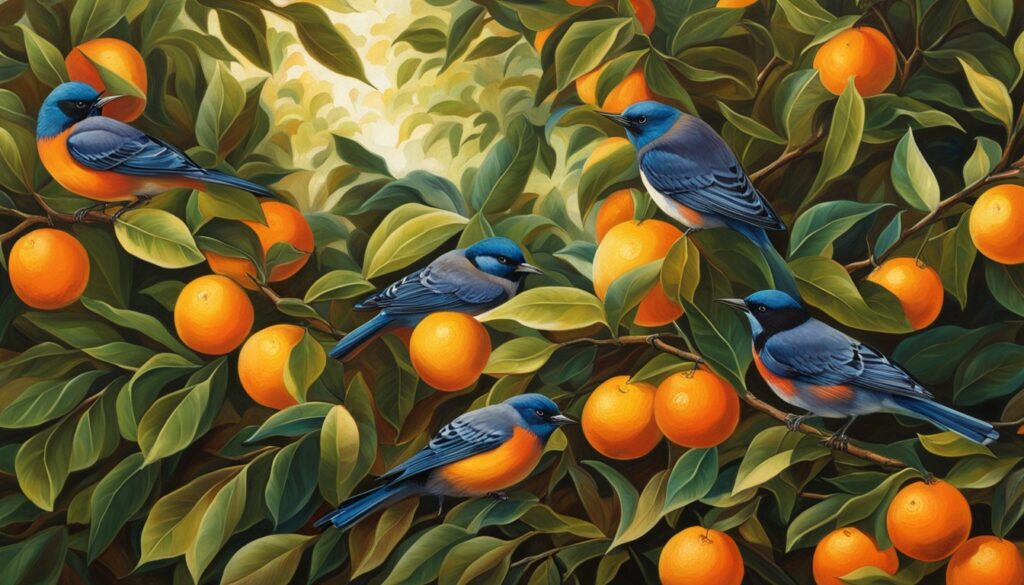
Identifying and Observing Visiting Birds
Creating a backyard orange feeding station is exciting. The real joy is in spotting and naming the birds that come. You can make bird identification and bird watching fun by focusing on the ones loving your oranges. They turn your garden into a fascinating place.
Tips for Bird Watching and Identification
Here are some tips for enjoying and learning from your backyard’s birds:
- Get to know the birds that like oranges, like orioles, tanagers, and house finches.
- Watch for unique traits in their appearance, actions, and sounds to recognize them easier.
- Keep a log of the various birds and how often they come.
- Use books, websites, or apps to help you name the birds you find.
- Be prepared to wait; some birds may come infrequently or only at specific times.
Active bird watching helps you love the colorful life in your garden. You also learn more about the habits of orange-eaters.
“Spotting birds at my orange feeder has been wonderfully surprising. Seeing a Western tanager at first felt like a big goldfinch visit. But watching closer, I spotted its unique traits and ways.”
With some patience and a sharp eye, you can find a lot of joy in bird identification and bird watching at home. Understanding what orange-eaters like makes it easier to bring in and enjoy these gorgeous birds.
Conclusion
This look at the wide range of backyard birds that love oranges showed us a bright, fun world. It ranged from the well-known Baltimore Orioles to the surprise Lazuli Buntings. These birds add color and joy to where they visit.
Placing orange feeders where birds can see them brings many new bird watchers to your yard. This approach allows you to grow your list of bird sightings. Plus, regularly putting out fresh oranges means these birds will keep coming back. This helps not only you but also the birds’ own communities.
Watching these birds in your own space brings happiness. It also links you to nature more closely. So, placing citrus feeders isn’t just good for the birds. It’s a great thing for everyone who loves birds and nature.
FAQ
What birds are attracted to oranges?
Many backyard birds enjoy feasting on oranges. Orioles, tanagers, bunting, and grosbeaks love them. Icons of the orange world, these birds flock to your trees.
When do birds visit orange feeders?
Orioles and tanagers come back in spring to eat oranges. House finches and grosbeaks chow down all summer long. It’s a treat for them, no matter the season.
Which bird species are known to eat oranges?
Eleven Eastern and Western U.S. bird species love oranges. This list includes orioles, tanagers, buntings, finches, and grosbeaks. They make your yard their sweet orange paradise.
How can I set up an orange feeder in my backyard?
The easiest way is to skewer orange halves on shepherd’s hooks. You can also use platform feeders. For a craftier option, make DIY feeders with nails or screws to attach the orange pieces.
How often should I replace the oranges in my feeder?
Orange feeders need a freshness check every few days. In the summer, check them daily. Warm weather makes fruit spoil faster. Keep your feeders clean and fruit fresh for happy birds.
What other benefits can offering oranges provide in my backyard?
Along with birds, oranges attract pretty butterflies and moths. They lead to a lively backyard full of color and fluttering life.
How can I identify the birds visiting my orange feeder?
Spotting new birds means staying watchful. Look closely and cross off your list of 11 birds known for seeking out oranges. They may surprise you with their visit.
